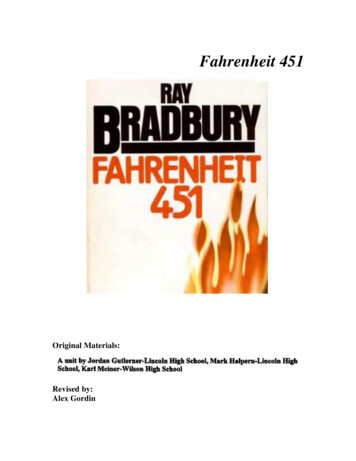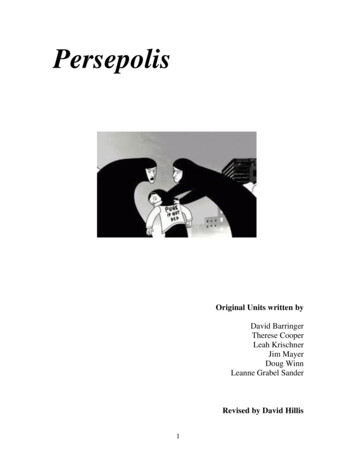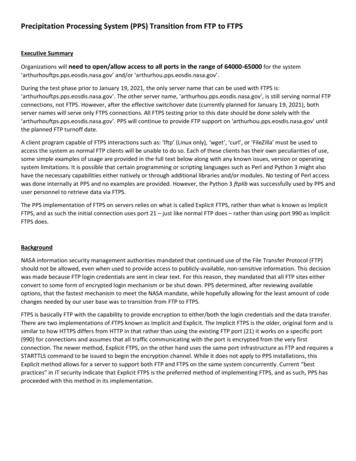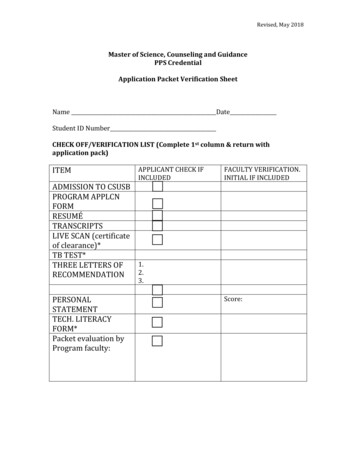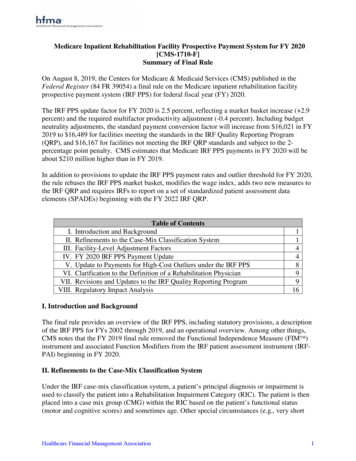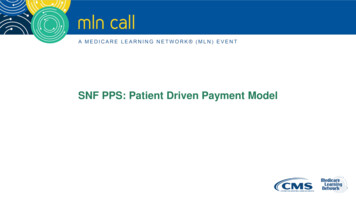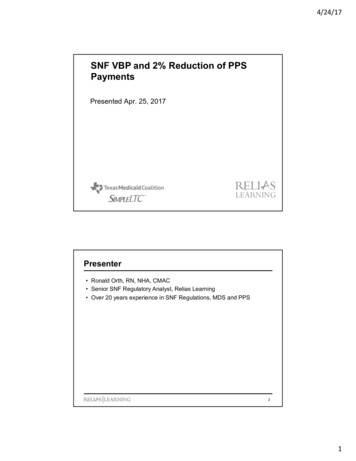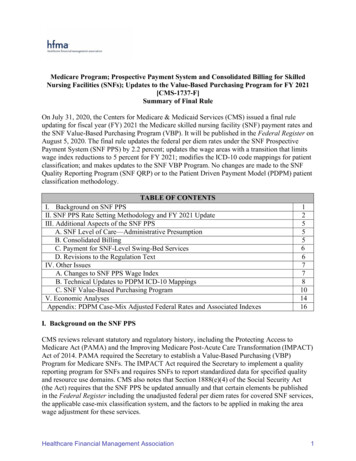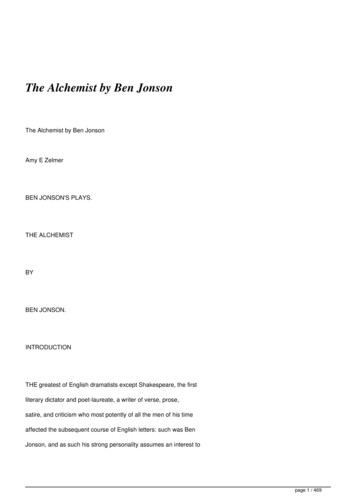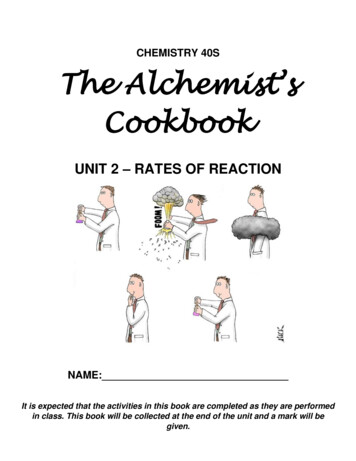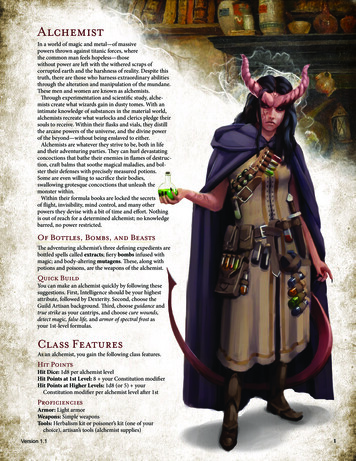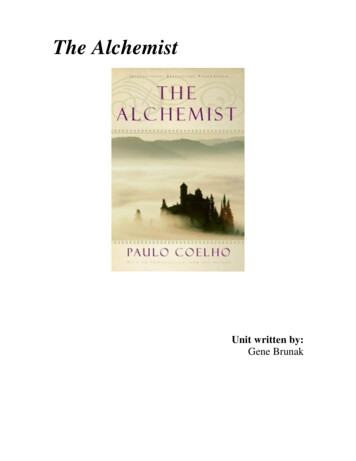
Transcription
The AlchemistUnit written by:Gene Brunak
Introduction to UnitConcerns have been expressed about the pessimistic nature of the body of workswidely available and taught at the sophomore level (Of Mice and Men, Night, AnimalFarm, Lord of the Flies, to name a few) – and the dearth of material that might provide amore optimistic perspective on things for the 10th graders.The Alchemist (by Paulo Coelho) would appear to be an opportunity to offer astory which provides hope, while also offering 10th grade students a contemporaryexample of something other than a “Western” perspective (in an academic year whichfrequently viewed as a “survey of world literature”). Having been translated into 41languages, the novel has captured the imagination of a wide audience beyond the UnitedStates; it could serve to help our students as they become “citizens of the world”.The Alchemist deals with universal themes (duty versus passion, loving andlosing, being taken advantage of) that many high school students (indeed, many people)faces on a regular basis.The beauty of this novel is that its perceived “simplicity” can (a) engage reluctantreaders, and (b) be a “springboard” for advanced readers (who can be encouraged to readother works of “magical realism” that are available to PPS students, including (but notlimited to) Gabriel Garcia-Marquez’s 100 Years of Solitude, Isabel Allende’s The Houseof the Spirits, Toni Morrison’s Beloved; students can also be encouraged to read otherCoelho works (Veronika Decides to Die is highly recommended for more sophisticatedreaders – similar thematically to The Alchemist, it examines the “will to live”, but alsodeals with suicide, mild sexuality). The Alchemist is also very cinematic (its film rightshaving been purchased by Laurence Fishburne); the film adaptation of Veronika Decidesto Die is slated to premier in 2010.In addition to exposing students to a richly rewarding novel and the literarytradition on magical realism, the unit helps students to develop close reading and analysisskills, particularly with theme and character. And because of the personal nature of thenarrative, the unit also asks students to improve their narrative writing abilities, which areassessed at various times throughout the unit and on the culminating assessment. Unlikemany others in this guide, this unit actually has two final assessments with the other onebeing a personal, independently designed project that synthesize the students’ knowledgeof the novel. Like Santigo, the protagonist in The Alchemist, your students will embarkon a journey that I hope is a satisfying and enriching one.1
The Alchemist Planning TemplateStage 1 – Desired ResultsPriority Standards (4-5 only): Number and brief summary10.07. Draw conclusions about reasons for actions/beliefs and support assertions10.09. Identify and analyze the development of themes10.10. Identify the qualities the character, and analyze the effect of these qualities10.12. Differentiate among the different types of fiction:10.15. Evaluate how literary elements (are used to establish mood, place, time period, and cultures, andcontribute to the development of its theme.10.18.10. Exclude extraneous details and inconsistencies.10.18.11. Reveal the significance of, the subject and events.10.18.12. Develop a commonplace, specific occasion as the basis for the reflectionUnderstandingsStudents will understand that Life is filled with cycles (Hero’s Journey)Santiago is an archetype, a symbolicrepresentation (in this case of “everyman”),conflicted by passion vs. duty.Essential QuestionsWhat is your Personal Legend?What “hats” do you wear (roles do you play)?What does it mean to lead a good life?How do we find meaning in life?Students will know .(facts and knowledge)What elements are associated with the genre of“magical realism”?How to interpret literature on a literal andmetaphorical level.Students will be able to .(apply skills)Write an effective, well supported personalnarrative.Summarize a story utilizing panels (storyboard).Stage 2 – Assessment EvidenceCulminating Assessment (authentic):Student Initiated/teacher approved projectand a Personal NarrativeOther Evidence (variety of forms and modes)Mandala (graphic organizer)Storyboard (graphic organizer)Story Map (graphic organizer)2
Stage 3: Learning Plan – The AlchemistActivity TitleLesson #1: “MagicalRealism” – “Very OldMan”Priority Standards10.12. Differentiate among the different types ofPage6fiction:10.15. Evaluate how literary elements (are used toestablish mood, place, time period, and cultures, andcontribute to the development of its theme.Lesson #2: PreAssessmentLesson #3:Metaphorical JourneysLesson #4: Choices andConsequencesLesson #5: Intro toNovelLesson #6:Dialectical Journal10.09. Identify and analyze the development of themes10.10. Identify the qualities the character, and analyzethe effect of these qualities10.18.10. Exclude extraneous details andinconsistencies.10.18.11. Reveal the significance of, the subject andevents.10.18.12. Develop a commonplace, specific occasion asthe basis for the reflection10.18.11. Reveal the significance of, the subject andevents.10.18.12. Develop a commonplace, specific occasion asthe basis for the reflection10.09. Identify and analyze the development of themes10.10. Identify the qualities the character, and analyzethe effect of these qualities10.07. Draw conclusions about reasons foractions/beliefs and support assertions10.09. Identify and analyze the development of themes10.10. Identify the qualities the character, and analyzethe effect of these qualities10.12. Differentiate among the different types offiction:10.15. Evaluate how literary elements (are used toestablish mood, place, time period, and cultures, andcontribute to the development of its theme.10.07. Draw conclusions about reasons foractions/beliefs and support assertions10.09. Identify and analyze the development of themes10.10. Identify the qualities the character, and analyzethe effect of these qualitiesLesson #7:Philosophical Chairs10.07. Draw conclusions about reasons forLesson #8: Children’sBook10.09. Identify and analyze the development of themesLesson #9: Mandala10.09. Identify and analyze the development of themes91524273341actions/beliefs and support assertions10.09. Identify and analyze the development of themes10.10. Identify the qualities the character, and analyzethe effect of these qualities4510.10. Identify the qualities the character, and analyzethe effect of these qualities346
Activity TitlePriority StandardsPage10.10. Identify the qualities the character, and analyzethe effect of these qualitiesLesson #10: Foundpoem10.09. Identify and analyze the development of themes10.18.10. Exclude extraneous details andinconsistencies.10.18.11. Reveal the significance of, the subject andevents.10.18.10. Exclude extraneous details andLesson #12: Narrativeinconsistencies.Elements10.18.11. Reveal the significance of, the subject andevents.10.18.12. Develop a commonplace, specific occasion asthe basis for the reflection10.18.10. Exclude extraneous details andCulminatingAssessment #1: Personal inconsistencies.10.18.11. Reveal the significance of, the subject andNarrativeevents.10.18.12. Develop a commonplace, specific occasion asthe basis for the reflection10.09. Identify and analyze the development of themesLesson #12: Parable of10.10. Identify the qualities the character, and analyzethe Elephantthe effect of these qualitiesLesson #11: Story mapCulminatingAssessment #2Alchemist ProjectLesson # 16Unit ReflectionResources4810.10. Identify the qualities the character, and analyzethe effect of these qualities4953626910.09. Identify and analyze the development of themesand other TBD by student7210.09. Identify and analyze the development of themes78794
Academic VocabularyGeneral literary anzaJuxtaposition“Magical realism”“Hero’s journey”Concepts from the novel:Soul of the WorldMaktubPersonal Legend5
Lesson #1 magical realism” – “A Very Old Man with Enormous Wings”Duration: 90 min.Priority Standards: 10.07, 10.12, 10.13, 10.15Overview: The Elements of Literature anthology (4th course), which every 10th gradestudent district wide should have access to, contains the short story “A Very Old ManWith Enormous Wings” by Gabriel Garcia-Marquez. Marquez, along with receiving aNobel Prize, is credited with popularizing the genre of “magical realism”. The genre hascome to be associated with writers from Latin America; Brazilian Paulo Coelho’s TheAlchemist is another example. Because of its complex - and unusual - nature, manystudents will need the teacher’s help in arriving at an understanding.Materials: Elements of Literature – 4th Course (Holt), Edward Scissorhands clipHook: If you have access to the film Edward Scissorhands, the first fifteen minutesmakes for a perfect introduction to the concept of magical realism. It starts with agrandmother telling her daughter about where snow comes from. In a seeming nonsequitur, she says it’s about “scissors,” but with this line, she takes us into a world that isboth magical and realistic, tinged with myth making. Continue to play as these twoworlds collide when Peg’s Avon Lady meets the fantastical Edward. End the film afterEdward has been introduced to Peg’s house and family. Ask students to write thebeginnings of a definition of “magical realism” from just this clip.Steps / Procedures:1. Begin reading the story “The Very Old Man ” aloud with students. Thelanguage and setting will seem difficult to students at first. Pause the reading oncethey have brought the old man back to their house and put him in the coop.2. Hand out the sheet with the description of “magical realism.” Divide the text intothree sections – intro/background, characteristics, and themes – and assign eachstudent one section. It’s a pretty scholarly article, so encourage them to mark upthe text and talk with their classmates about their sections. Ask students to preparea brief summary of their section, along with questions they have. Next, askstudents to identify what they have seen in Edward Scissorhands and/or the storyso far that seems like magical realism according to the article.3. Continue to read the story, though you may want students to read it aloud in pairsor groups and independently at times. Afterward, you may want to direct studentsto discuss the accompanying questions, especially those that relate to the theme.4. This story can also serve as a discussion for how “magical realism” hasinfluenced art in the United States, including many films* (Pan’s Labyrinth, LikeWater for Chocolate. A more recent example would be Terry Gilliam’s film TheImaginarium of Doctor Parnassus. Though teachers clearly should use carefuldiscretion, cinema can be an effective way to engage many of today’s “screensavvy” students; selecting a film that focuses on similar themes (rather than thefilm adaptation of the work itself) can be used to reinforce key ideas andconcepts, and help a student recognize a writer’s style. There is a film version(though not widely available) of this story – Garcia-Marquez wrote thescreenplay.6
Magical RealismA literary mode rather than a distinguishable genre, magical realism aims to seize theparadox of the union of opposites. For instance, it challenges polar opposites like life anddeath and the pre-colonial past versus the post-industrial present. Magical realism ischaracterized by two conflicting perspectives, one based on a rational view of reality andthe other on the acceptance of the supernatural as prosaic reality. Magical realism differsfrom pure fantasy primarily because it is set in a normal, modern world with authenticdescriptions of humans and society. According to Angel Flores, magical realism involvesthe fusion of the real and the fantastic, or as he claims, "an amalgamation of realism andfantasy". The presence of the supernatural in magical realism is often connected to theprimeval or "magical’ Indian mentality, which exists in conjunction with Europeanrationality. According to Ray Verzasconi, as well as other critics, magical realism is "anexpression of the New World reality which at once combines the rational elements of theEuropean super-civilization, and the irrational elements of a primitive America."Gonzalez Echchevarria believes that magical realism offers a world view that is not basedon natural or physical laws nor objective reality. However, the fictional world is notseparated from reality either.BackgroundThe term "magical realism" was first introduced by Franz Roh, a German art critic, whoconsidered magical realism an art category. To him, it was a way of representing andresponding to reality and pictorially depicting the enigmas of reality. In Latin America inthe 1940s, magical realism was a way to express the realistic American mentality andcreate an autonomous style of literature.Characteristics of Magical RealismHybridity—Magical realists incorporate many techniques that have been linked to postcolonialism, with hybridity being a primary feature. Specifically, magical realism isillustrated in the inharmonious arenas of such opposites as urban and rural, and Westernand indigenous. The plots of magical realist works involve issues of borders, mixing, andchange. Authors establish these plots to reveal a crucial purpose of magical realism: amore deep and true reality than conventional realist techniques would illustrate.Irony Regarding Author’s Perspective—The writer must have ironic distance from themagical world view for the realism not to be compromised. Simultaneously, the writermust strongly respect the magic, or else the magic dissolves into simple folk belief orcomplete fantasy, split from the real instead of synchronized with it. The term "magic"relates to the fact that the point of view that the text depicts explicitly is not adoptedaccording to the implied world view of the author. As Gonzales Echevarria express
The Alchemist is also very cinematic (its film rights having been purchased by Laurence Fishburne); the film adaptation of Veronika Decides to Die is slated to premier
